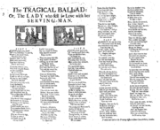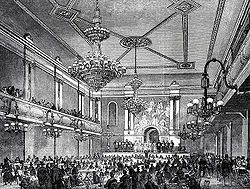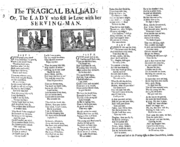
Early British popular music
Encyclopedia

Print culture
Print culture embodies all forms of printed text and other printed forms of visual communication. One prominent scholar in the field is Elizabeth Eisenstein, who contrasted print culture, which appeared in Europe in the centuries after the advent of the Western printing-press , to scribal culture...
, which were sold cheaply and in great numbers until the nineteenth century. Further technological, economic and social changes led to new forms of music in the nineteenth century, including the brass band
Brass band
A brass band is a musical ensemble generally consisting entirely of brass instruments, most often with a percussion section. Ensembles that include brass and woodwind instruments can in certain traditions also be termed brass bands , but are usually more correctly termed military bands, concert...
, which produced a popular and communal form of classical music. Similarly, the Music hall
Music hall
Music Hall is a type of British theatrical entertainment which was popular between 1850 and 1960. The term can refer to:# A particular form of variety entertainment involving a mixture of popular song, comedy and speciality acts...
sprang up to cater for the entertainment of new urban societies, adapting existing forms of music to produce popular songs and acts. In the 1930s the influence of American Jazz
Jazz
Jazz is a musical style that originated at the beginning of the 20th century in African American communities in the Southern United States. It was born out of a mix of African and European music traditions. From its early development until the present, jazz has incorporated music from 19th and 20th...
led to the creation of British dance band
British dance band
British dance bands developed a unique style of popular jazz and dance music during the 1920s and 1930s that developed in British dance halls and hotel ballrooms thousands of miles away from the true origins of jazz...
s, who provided a social and popular music that began to dominate social occasions and the radio airwaves.
Broadside ballads

Chapmen
A chapman was an itinerant dealer or hawker in early modern Britain.-Etymology:Old English céapmann was the regular term for "dealer, seller", cognate to the synonymous Dutch koopman....
in city streets or at fairs. The subject matter varied from what has been defined as the traditional ballad, although many traditional ballads were printed as broadsides. Among the topics were love, religion, drinking-songs, legends, and early journalism, which included disasters, political events and signs, wonders and prodigies.
Brass bands
Although the most of the instruments used by British brass bands had existed and had been used together for some time they only became a mass activity in the 1840s and 1850s out of village, church and military bands. Brass bands were a response to the process of industrialisation, which produced a large working class population, technological advancements, including more efficient piston valve instruments which were easier to play and more accurate, and mass production that could quickly produce and distribute the instruments. Arguably brass bands were an expression of the local solidarity and aspirations of newly formed or rapidly growing communities. This was particularly expressed in the rapid growth and organisation of bands, clearly seen in the creation of brass band competitions by the late 1850s. Brass bands probably reached their peak of popularity in the early decades of the twentieth century, when, it has been estimated there were over 20,000 brass band instrumentalists in the country.Parlour music
"Parlour music" was popular music performed in the parlourParlour
Parlour , from the French word parloir, from parler , denotes an "audience chamber". In parts of the United Kingdom and the United States, parlours are common names for certain types of food service houses, restaurants or special service areas, such as tattoo parlors...
s of middle class
Middle class
The middle class is any class of people in the middle of a societal hierarchy. In Weberian socio-economic terms, the middle class is the broad group of people in contemporary society who fall socio-economically between the working class and upper class....
homes by amateur singers and pianists
Piano
The piano is a musical instrument played by means of a keyboard. It is one of the most popular instruments in the world. Widely used in classical and jazz music for solo performances, ensemble use, chamber music and accompaniment, the piano is also very popular as an aid to composing and rehearsal...
. Disseminated as sheet music
Sheet music
Sheet music is a hand-written or printed form of music notation that uses modern musical symbols; like its analogs—books, pamphlets, etc.—the medium of sheet music typically is paper , although the access to musical notation in recent years includes also presentation on computer screens...
, its heyday came in the 19th century, as a result of a steady increase in the number of households with enough surplus cash to purchase musical instruments and instruction in music, and with the leisure time and cultural motivation to engage in recreational music-making. In contrast to the chord-based classical music
Classical music
Classical music is the art music produced in, or rooted in, the traditions of Western liturgical and secular music, encompassing a broad period from roughly the 11th century to present times...
, parlour music features melodies
Melody
A melody , also tune, voice, or line, is a linear succession of musical tones which is perceived as a single entity...
which are harmonically-independent or not determined by the harmony
Harmony
In music, harmony is the use of simultaneous pitches , or chords. The study of harmony involves chords and their construction and chord progressions and the principles of connection that govern them. Harmony is often said to refer to the "vertical" aspect of music, as distinguished from melodic...
. Many of the earliest parlour songs were transcriptions
Transcription (music)
In music, transcription can mean notating a piece or a sound which was previously unnotated, as, for example, an improvised jazz solo. Further examples include ethnomusicological notation of oral traditions of folk music, such as Béla Bartók's and Ralph Vaughan Williams' collections of the national...
for voice and keyboard of other music, such as Thomas Moore
Thomas Moore
Thomas Moore was an Irish poet, singer, songwriter, and entertainer, now best remembered for the lyrics of The Minstrel Boy and The Last Rose of Summer. He was responsible, with John Murray, for burning Lord Byron's memoirs after his death...
's Irish Melodies which comprised traditional tunes with new lyrics. Other genres performed included arias from Italian operas, patriotic selections, religious songs, and pieces written for the musical stage, including excerpts from blackface
Blackface
Blackface is a form of theatrical makeup used in minstrel shows, and later vaudeville, in which performers create a stereotyped caricature of a black person. The practice gained popularity during the 19th century and contributed to the proliferation of stereotypes such as the "happy-go-lucky darky...
minstrel shows. As the 19th century wore on, more and more songs were newly composed specifically for use by amateurs at home, and these pieces began to develop a style all their own: similar in melodic and harmonic content to art songs of the day, but shorter and simpler in structure and making fewer technical demands on singer and accompanist. The high point of the parlour song came in the late 19th and early 20th centuries, in North America and the British Isles. Songs became more complex and sophisticated in their melodic and harmonic vocabulary, and in addition to their continuing use in the parlour were also often sung in public recitals by professional singers. Characteristic and popular parlour songs include "Home, Sweet Home," by Henry Bishop with lyrics by John Howard Payne
John Howard Payne
John Howard Payne was an American actor, poet, playwright, and author who had most of his theatrical career and success in London. He is today most remembered as the creator of "Home! Sweet Home!", a song he wrote in 1822 that became widely popular in the United States, Great Britain, and the...
, "The Old Arm Chair" by Henry Russell
Henry Russell (musician)
Henry Russell was an English pianist, baritone singer and composer, born into a distinguished Jewish family.-Biography:...
, "The Lost Chord" composed by Arthur Sullivan
Arthur Sullivan
Sir Arthur Seymour Sullivan MVO was an English composer of Irish and Italian ancestry. He is best known for his series of 14 operatic collaborations with the dramatist W. S. Gilbert, including such enduring works as H.M.S. Pinafore, The Pirates of Penzance and The Mikado...
with lyrics by Adelaide A. Proctor, and "Take Back the Heart" by Claribel (Mrs. Charlotte Barnard).
Music hall
Music hall developed as a result of the rapid industrialisationIndustrialisation
Industrialization is the process of social and economic change that transforms a human group from an agrarian society into an industrial one...
and urbanisation of previously rural populations in the nineteenth century. The new urban communities, cut off from their cultural roots, required new and accessible means of entertainment. Music halls were originally bars which provided entertainment, in the form of music
Music
Music is an art form whose medium is sound and silence. Its common elements are pitch , rhythm , dynamics, and the sonic qualities of timbre and texture...
and speciality acts, for their patrons. By the middle years of the 19th century the first purpose-built music halls were being built in London. The halls created a demand for new and catchy popular songs that could no longer be met from the traditional folk repertoire. Professional songwriters were enlisted to fill the gap. By the turn of the century Music hall was dominated by song writing companies and theatre chains such as that of Sir Oswald Stoll. Music hall songs are characterized by a simple beat
Beat (music)
The beat is the basic unit of time in music, the pulse of the mensural level . In popular use, the beat can refer to a variety of related concepts including: tempo, meter, rhythm and groove...
and a strong melody
Melody
A melody , also tune, voice, or line, is a linear succession of musical tones which is perceived as a single entity...
or tune
Melody
A melody , also tune, voice, or line, is a linear succession of musical tones which is perceived as a single entity...
which can be easily acquired by the audience. Typically a music hall song consists of a series of verses sung by the performer alone, and a repeated chorus
Refrain
A refrain is the line or lines that are repeated in music or in verse; the "chorus" of a song...
which carries the principal melody, and in which the audience is encouraged to join. Leading music hall stars included: Marie Lloyd
Marie Lloyd
Matilda Alice Victoria Wood was an English music hall singer, best known as Marie Lloyd. Her ability to add lewdness to the most innocent of lyrics led to frequent clashes with the guardians of morality...
, Harry Champion
Harry Champion
William Crump , better known by the stage name Harry Champion, was an English music hall composer, singer and Cockney comedian, whose onstage persona appealed chiefly to the working class communities of East London...
, George Formby
George Formby
George Formby, OBE , born George Hoy Booth, was a British comedy actor, singer-songwriter, and comedian. He sang light, comical songs, accompanying himself on the banjo ukulele or banjolele...
, Vesta Tilley, Gus Elen, Little Tich , Gracie Fields
Gracie Fields
Dame Gracie Fields, DBE , was an English-born, later Italian-based actress, singer and comedienne and star of both cinema and music hall.-Early life:...
, Flanagan and Allen
Flanagan and Allen
Flanagan and Allen were a British singing and comedy double act popular during World War II. Its members were Bud Flanagan and Chesney Allen...
. Musical hall composers included Lionel Monckton
Lionel Monckton
Lionel John Alexander Monckton was an English writer and composer of musical theatre. He was Britain's most popular musical theatre composer of the early years of the 20th century.-Early life:...
, Felix Powell
Felix Powell
Felix Lloyd Powell was a British Staff Sergeant most famous for writing the music for marching song "Pack Up Your Troubles in Your Old Kit Bag and Smile, Smile, Smile", in 1915...
, and Noel Gay
Noel Gay
Noel Gay was born Reginald Moxon Armitage. He also used the name Stanley Hill professionally. He was a successful British composer of popular music of the 1930s and 1940s whose output comprised 45 songs as well as the music for 28 films and 26 London shows...
.
Dance bands (big bands)
From about 1925 to 1946 the most popular form of music in the UK was that produced by Dance Bands. The British Bands never quite adopted the kind of "Swing" music that was generally associated American "Big Band" jazz. It was quite tame compared to American jazz and was generally more sweet. Billy CottonBilly Cotton
William Edward Cotton , better known as Billy Cotton, was a British band leader and entertainer, one of the few whose orchestras survived the dance band era. Today, he is mainly remembered as a 1950s and 1960s radio and television personality, although his musical talent emerged as early as the 1920s...
had perhaps the longest fame, as he still had a prime-time TV programme until the late 60s. The fame of Ted Heath
Ted Heath (bandleader)
Ted Heath, musician and big band leader, led Britain's greatest post-war big band recording more than 100 albums and selling over 20 million records...
lasted until 1964. Fans tended to divide them into "Sweet" (Ambrose
Ambrose (bandleader)
Benjamin Baruch Ambrose , known professionally as Ambrose or Bert Ambrose, was an English bandleader and violinist. Ambrose become the leader of a highly acclaimed English dance band, the Bert Ambrose & His Orchestra, in the 1930s.-Early life:Ambrose was born in the East End of London; his father...
, Geraldo
Gerald Bright
Gerald Walcan Bright, better known as Geraldo was a British bandleader....
and Victor Silvester
Victor Silvester
Victor Marlborough Silvester OBE was an English dancer, author, musician and dance band leader. He was a significant figure in the development of ballroom dance during the first half of the 20th century, and his records sold 75 million copies from the 1930s through to the 1980s.- Early life...
) and "Hot" (Harry Roy, Nat Gonella
Nat Gonella
Nathaniel Charles Gonella was an English jazz trumpeter, bandleader, vocalist and mellophonist born in London, perhaps most notable for his work with the big band he founded, The Georgians....
). Jack Hylton
Jack Hylton
Jack Hylton was a British band leader and impresario.He was born John Greenhalgh Hilton in the Great Lever area of Bolton, Lancashire, the son of George Hilton, a cotton yarn twister. His father was an amateur singer at the local Labour Club and Jack learned piano to accompany him on the stage...
's band was "hot" until 1933, then became sweeter as their success grew. Some of the lead singers enjoyed fame on their own. Most famous was Al Bowlly and Leslie "Hutch" Hutchinson
Leslie Hutchinson
Leslie Arthur Julien Hutchinson, known as "Hutch" was one of the biggest cabaret stars in the world during the 1920s and 1930s.-Career:...
.

